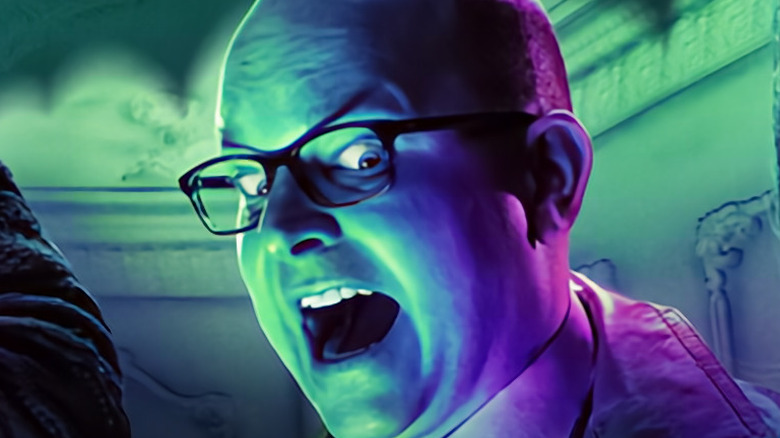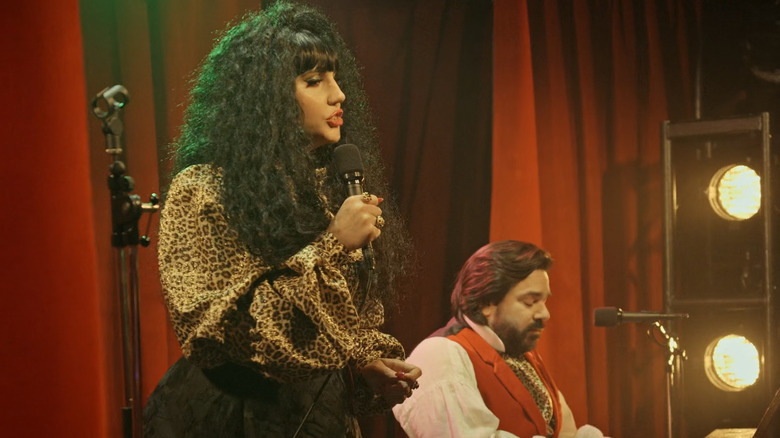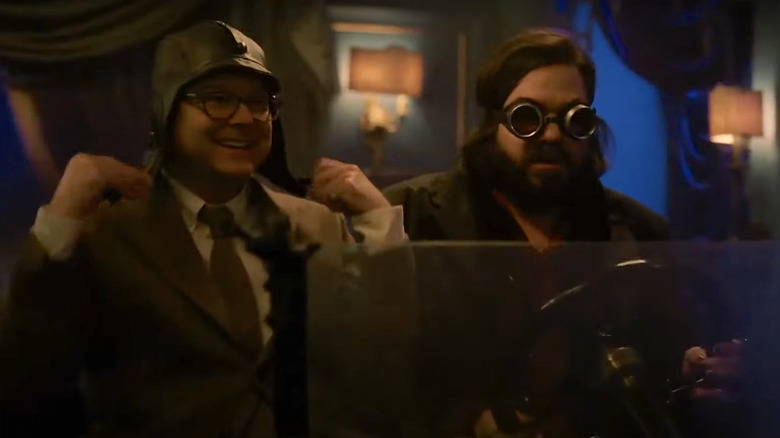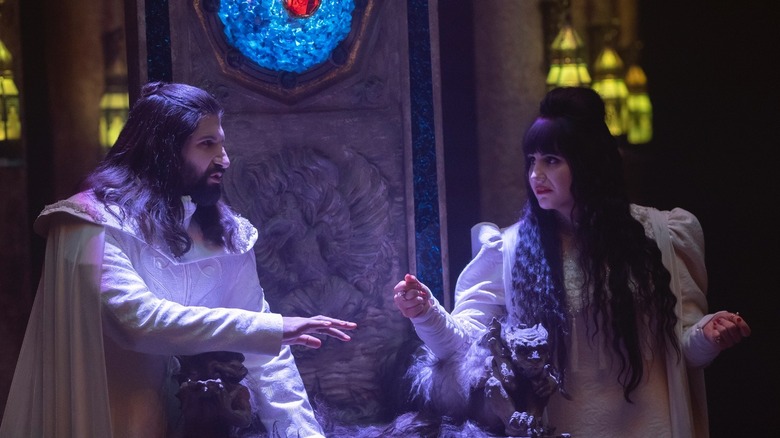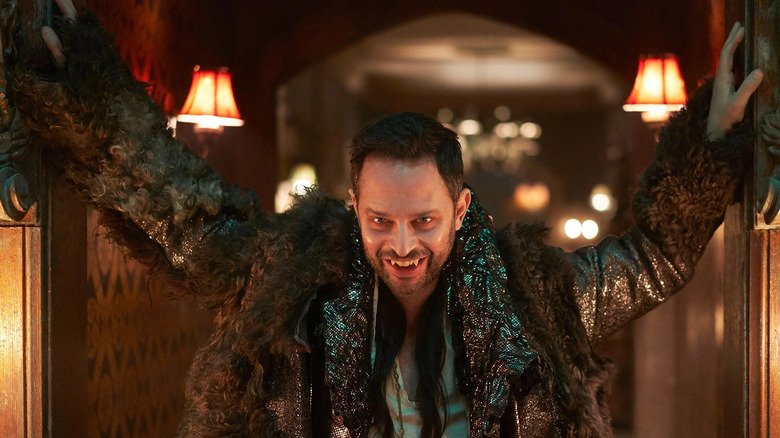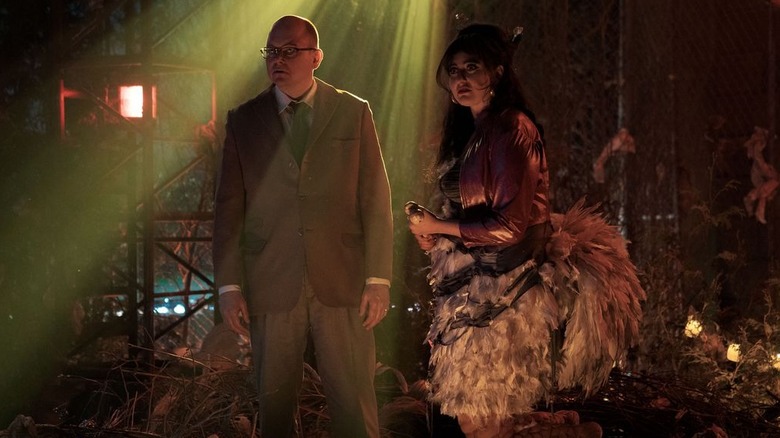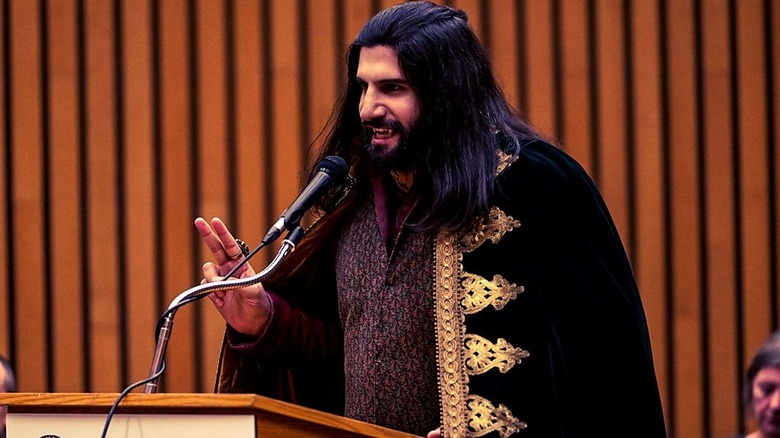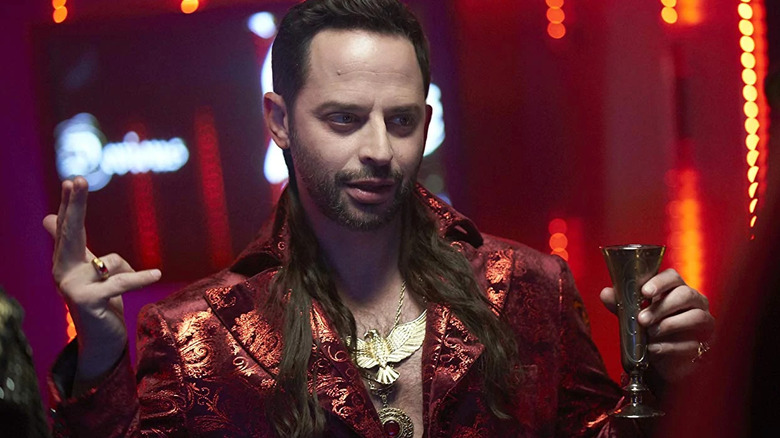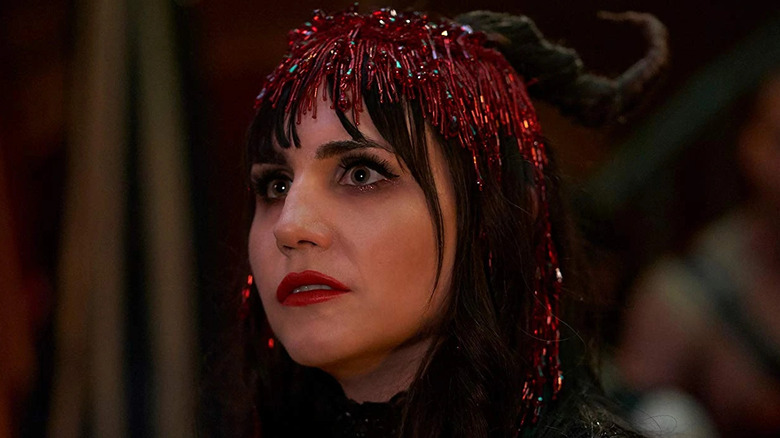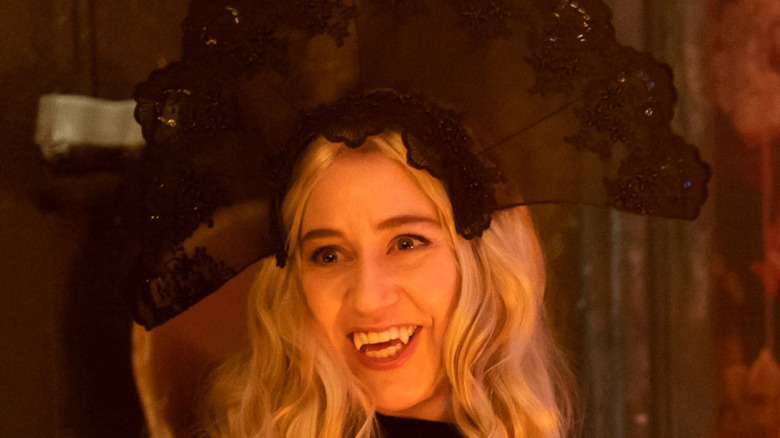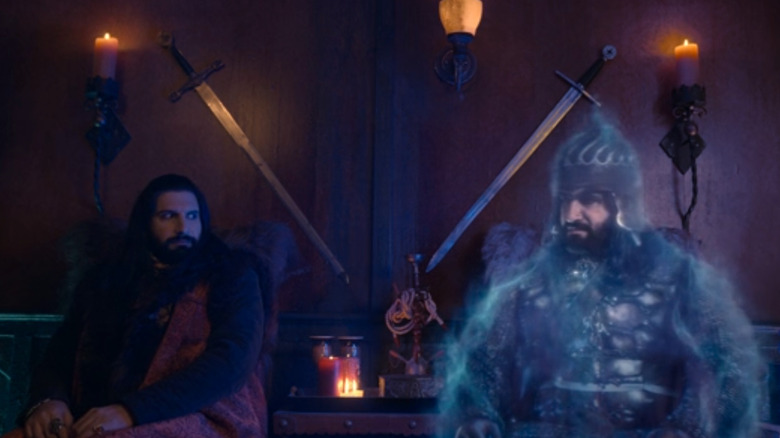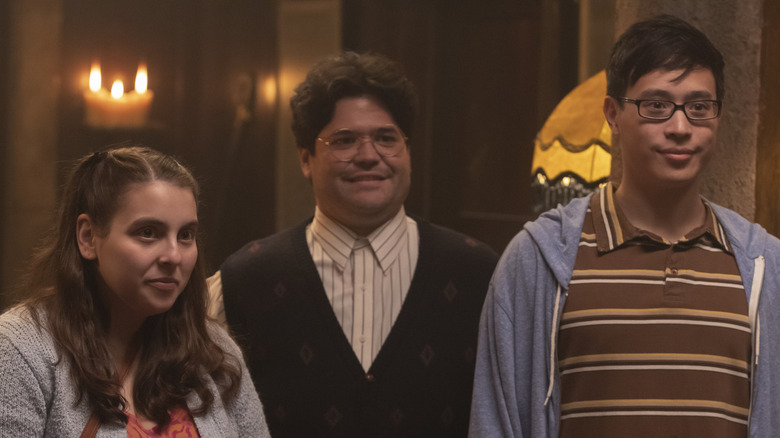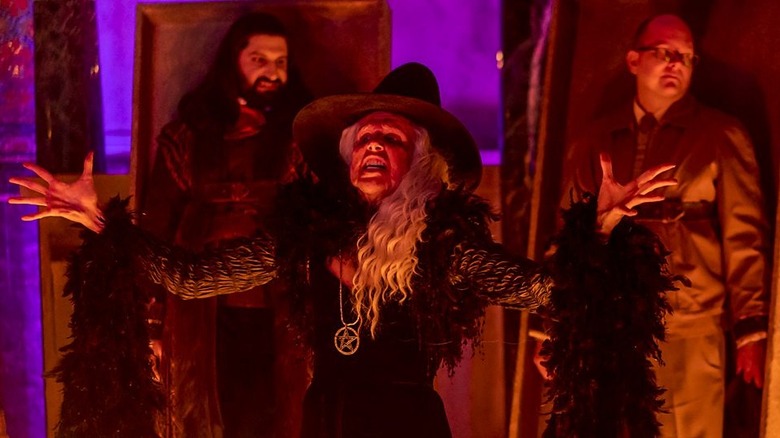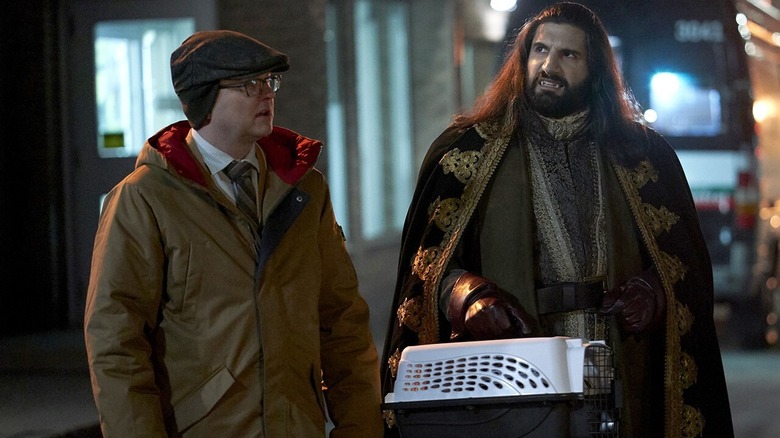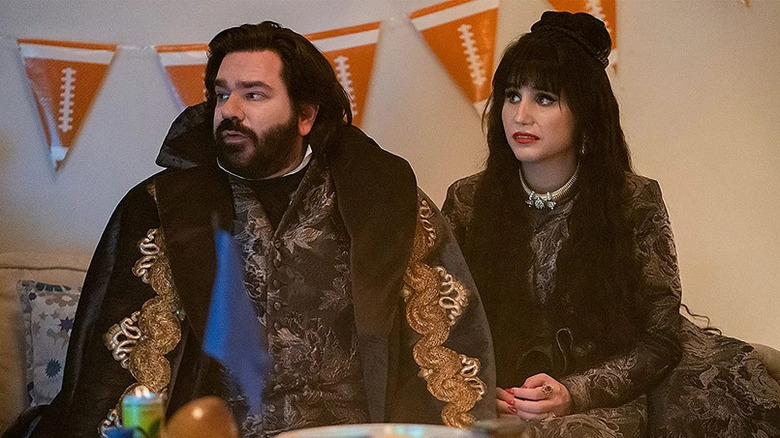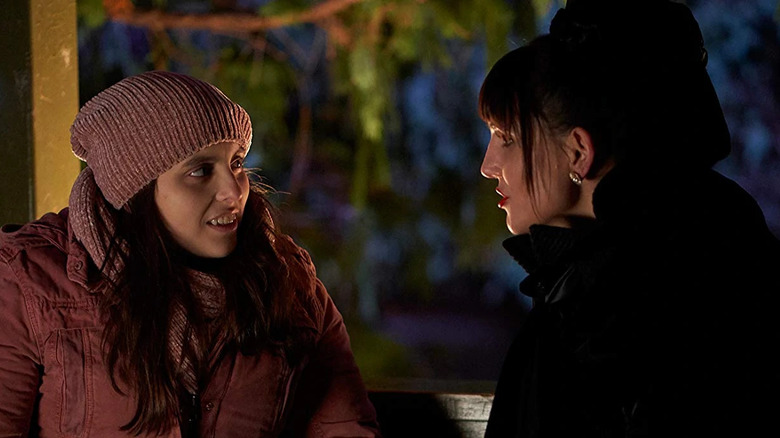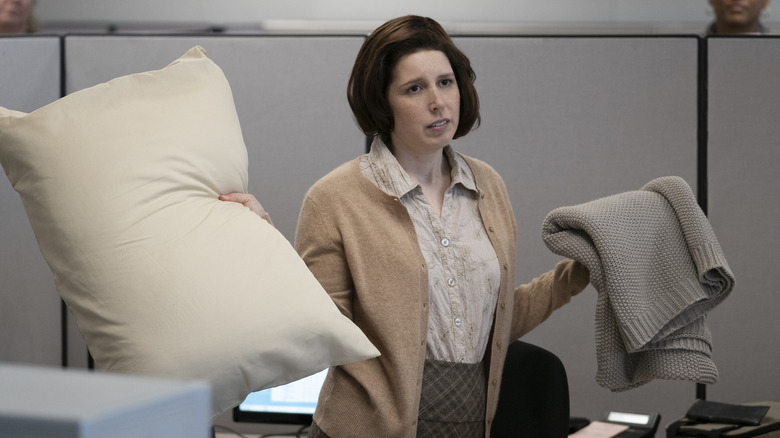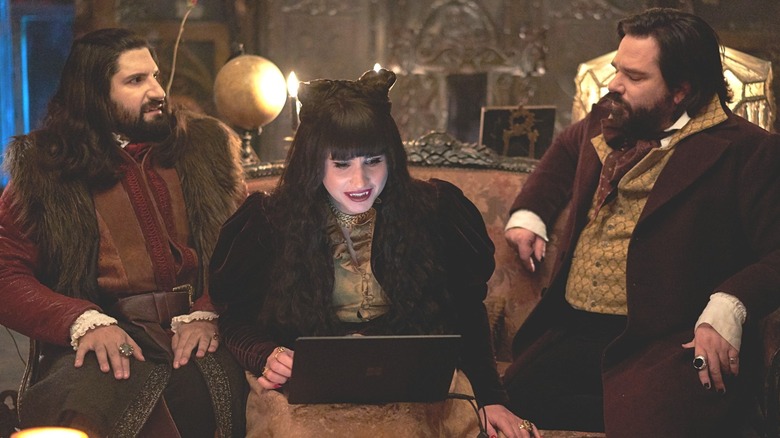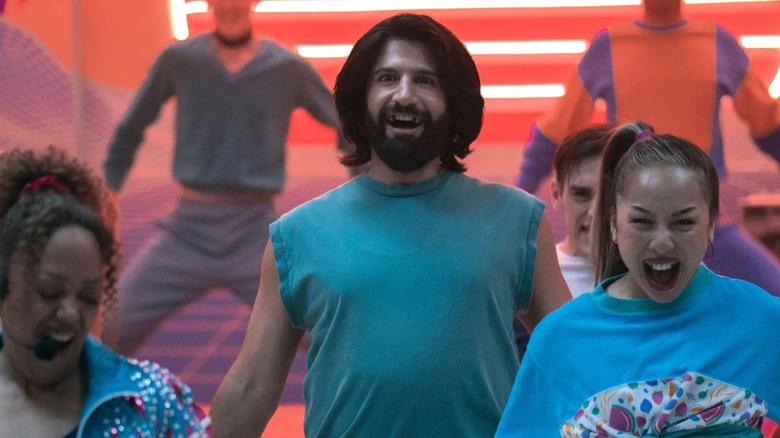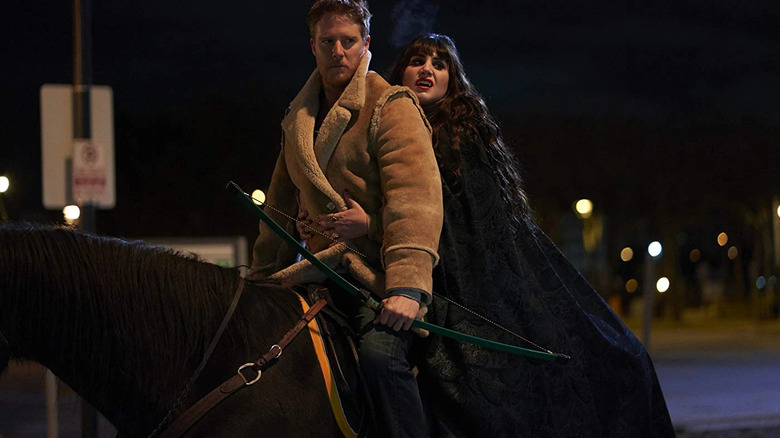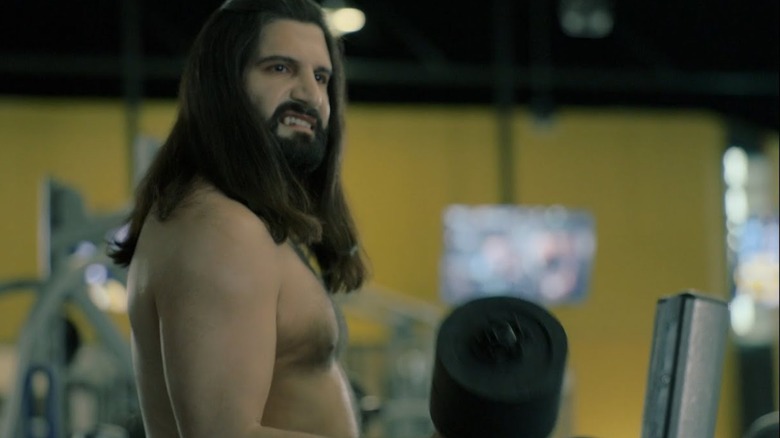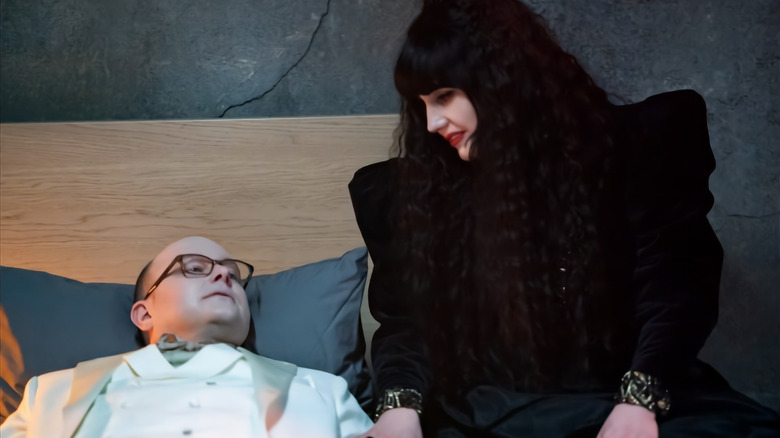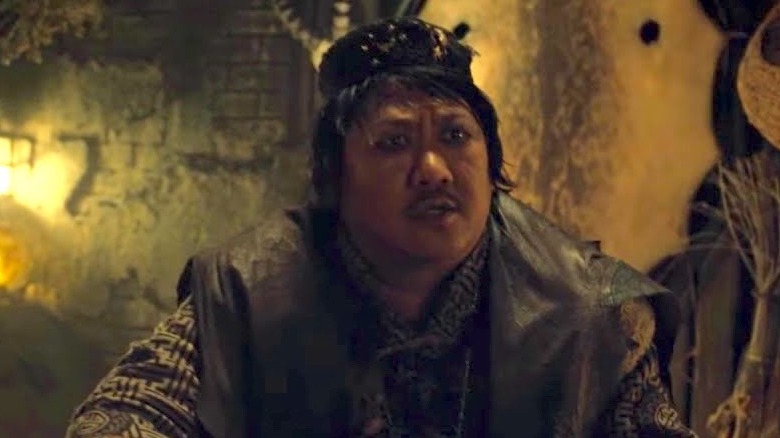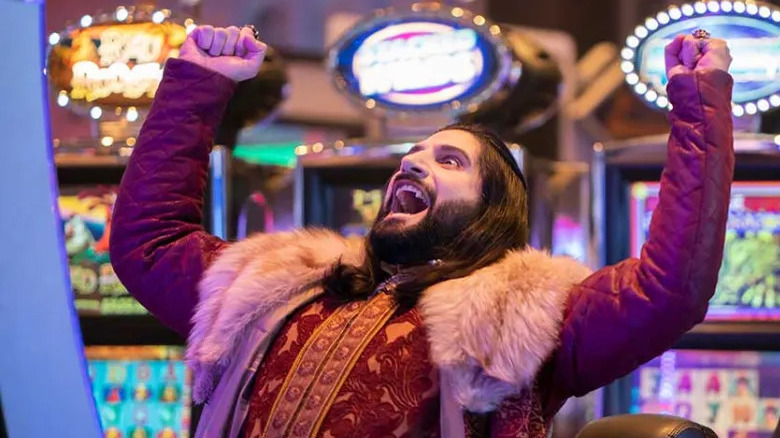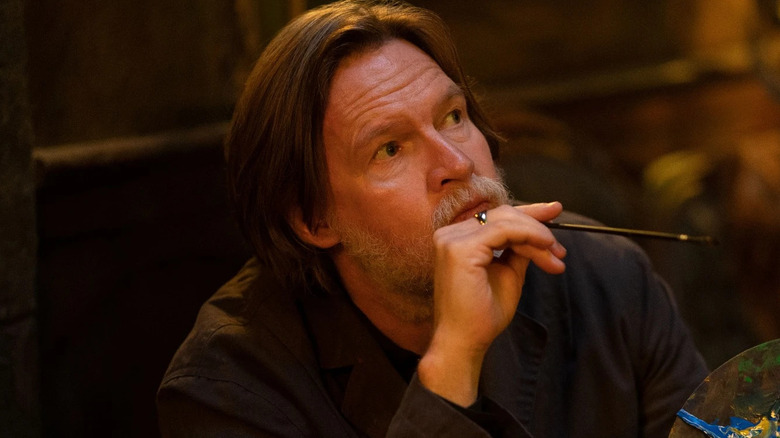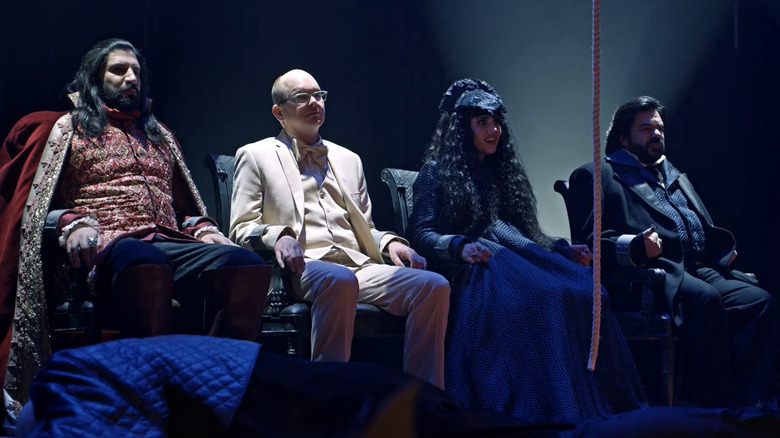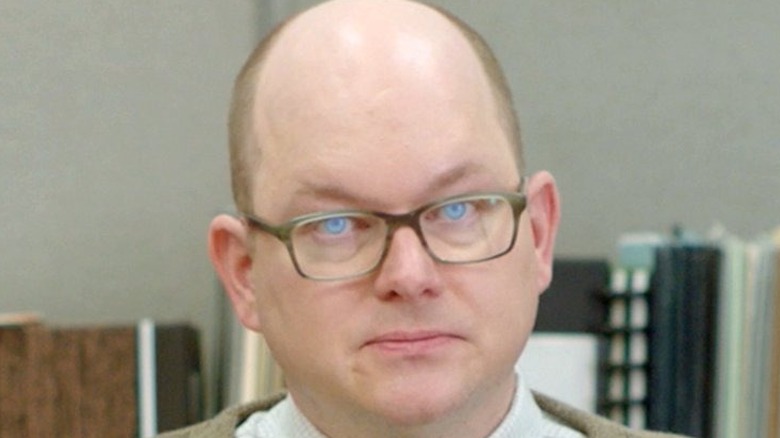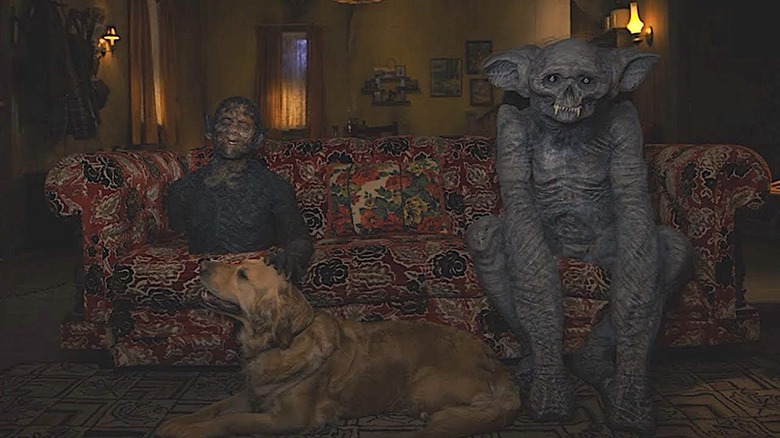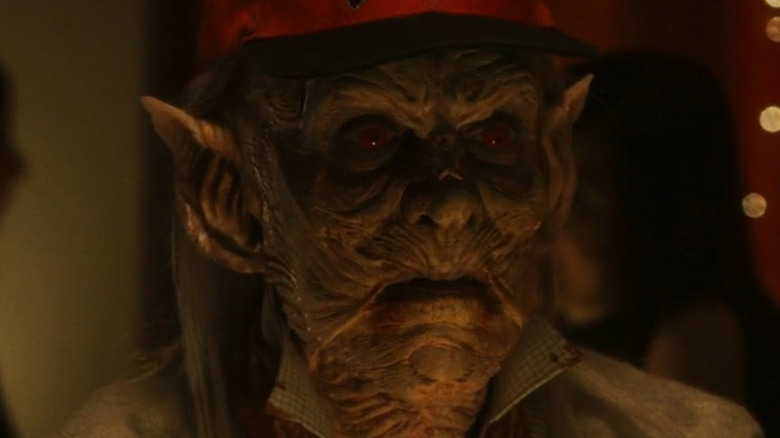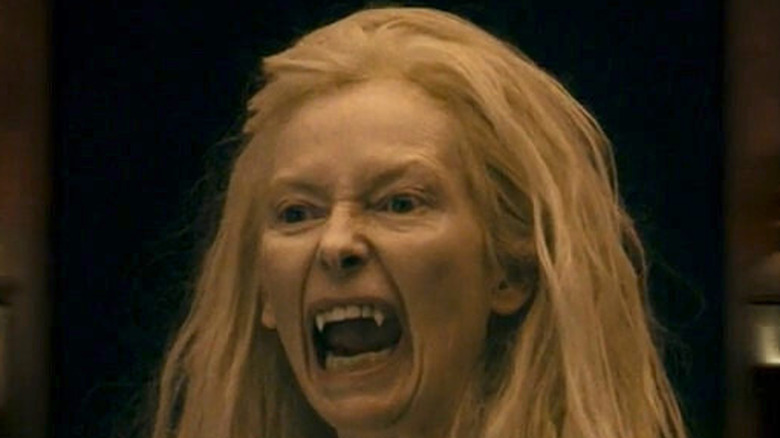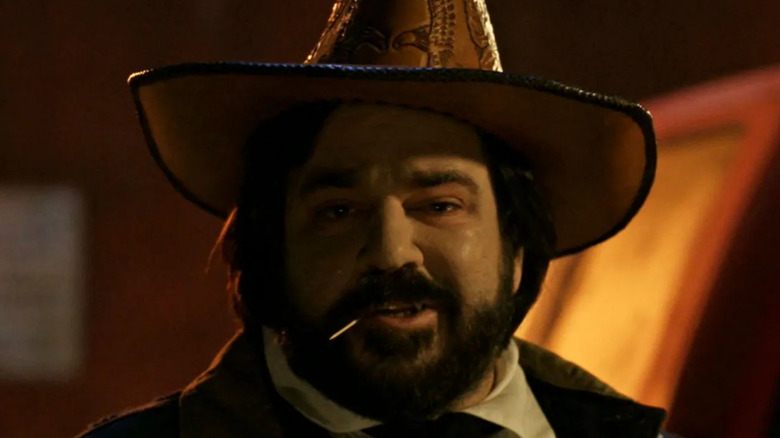Every Episode Of What We Do In The Shadows Ranked From Worst To Best
Imagine this: a much-beloved cult classic film that helped launch one of today's hottest writer/directors to stardom, a film with a refreshingly unique juxtaposition of tone and format, receives a spinoff — one adapted for television, with none of the original cast returning. No one could be blamed for assuming the worst, that a promising franchise would be cashed in and left with a black spot.
Yet, the television show in question, "What We Do in the Shadows," a spinoff of the Jemaine Clement/Taika Waititi mockumentary of the same name, has surprised audiences by being ... dare we say it ... as good, possibly even better, than its source material? From the cast to the writing to an uncommon comedic commitment to practical effects, the "Shadows" series has become one of the most consistently inventive shows on TV.
Since its 2019 debut, "Shadows" has treated fans to three seasons and thirty prime cut episodes of grade-A television. But, as any vampire will tell you, some slabs of meat are tastier than others. To help locate the choicest cut, here is every episode of "What We Do in the Shadows," ranked from worst to best.
30. Collaboration (Season 2, Episode 8)
"What We Do in the Shadows" centers around vampires, familiars, and werewolves, but deeper than that, it centers around family. Aside from perhaps the much-beloved dynamic between Nandor the Relentless (Kayvan Novak) and his familiar (and wannabe vampire) Guillermo de la Cruz (Harvey Guillen), nowhere in "What We Do in the Shadows" is the concept of family better embodied than the centuries-long marriage between Nadja of Antipaxos (Natasia Demetriou) and Laszlo Cravensworth (Matt Berry). The duo is in every way each other's opposite and yet each other's perfect compliment. Case in point: their folk duo, which, depending on how seriously you take Laszlo's braggadocio, may or may not have created some of the most famous songs of the last few hundred years. Like, as in, "Come on Eileen."
Laszlo is a consummate narcissist, and seemingly every other comment he delivers to the documentary camera crew includes some self-congratulatory moment or would-be impressive anecdote. Because of that constant self-inflation, the truth behind Laszlo's songwriting claims are in doubt throughout all of "Collaboration," but Nadja is always there, accepting his every word — perhaps not as truth, but just as Laszlo. And for every dirty version of a beloved standard Laszlo produces, Nadja hums along, in love with her partner and his passions. It's a testament to "What We Do in the Shadows" that "Collaboration" — which is better than probably 9 out of 10 random episodes of most other network "comedies" — ranks as the lowest entry on this list. And, next time you're slow-grooving along to "Kokomo," be sure to thank Nadja and Laszlo, since they apparently wrote it.
29. Gail (Season 3, Episode 3)
Season 3 of "What We Do in the Shadows" introduced a season-long arc revolving around Nandor's growing depression, stemming in parts from his torturously long life, his lack of direct family, and his unluckiness in love. One of the season's lowest points for Nandor (and then highest, then lowest, etc...) was the episode "Gail," in which his decades-long on-again-off-again romance with the titular human resurfaces, guaranteed to bolster his heart once more and then re-break it.
It's tough to see Nandor hurt, especially so many times in a row by the same person, but the episode gives viewers a number of breaks from the heartbreak. Laszlo fixes up an old jalopy and takes Colin Robertson (Mark Proksch, arguably the best character on the show as an energy-sucking vampire who wields tedium as if it were a deadly sword) on a loud, smog-filled joyride. The baffling baseball scene from "Twilight" gets a direct sendup in the form of a vampire/werewolf kickball game. The titular Gail, already a werewolf, dies and is saved when Nandor makes her a vampire, and so we get our first glimpse of a vampire-werewolf hybrid. To put it diplomatically, Gail's hybrid form is about as far from the "Underworld" uber-hybrid as possible. Lastly, the real high point of "Gail" is Nadja's constant concern for Nandor's emotional wellbeing. Though the house misinterprets it as cattiness, it is in actuality what Nandor always desired: unconditional love.
28. The Chamber of Judgement (Season 3, Episode 5)
Residing at the very bottom of IMDb's user ratings, this episode is not remembered fondly by many. Nevertheless, sitting at the bottom rung on the IMDb ladder for "Shadows" still puts this episode at a respectable 7.6 out of 10, which most TV series would love to receive for a given episode.
Perhaps the lackluster response is because "Chamber" introduces a few of dynamite concepts that it just doesn't have the willingness to pursue to their full potential. The A story follows Nadja and Nandor as they commence their duties as co-judges over a vampiric tribunal. Unable to decide which of their butts should reside on the single throne, they use Guillermo as their proxy, leading to a surge of dramatic irony as he is forced to pass judgment on a former friend whom he unwittingly turned into a vampire. Guillermo, meanwhile, thinks he is manipulating them both and that he is the one with the real power. But, like the B story involving Laszlo's neighbor (and inexplicable best friend) Sean falling into a pyramid scheme, it never quite pays off with the Gatling gun of laughs to which other episodes have made fans accustomed.
27. The Return (Season 2, Episode 7)
Season two of "What We Do in the Shadows" was a masterclass in subtle world-building. In the uncertainty of a first season, it makes sense to keep stories contained, scout fewer locations, and keep the special effects budget low. Then, in Season 2, once it was clear that the little televised baby had legs, there was finally real freedom to travel. That's exactly what "What We Do in the Shadows" did, as the world of vampires and werewolves we knew suddenly revealed its greater scope in Season 2. We become aware of an entire underworld ecosystem of zombies, necromancers, ghosts, witches, and — in the case of "The Return" — trolls.
Like the well-written modern fantasy it is, the show made sure to touch on the multiple meanings for the word troll these days, resulting in a fun little gag. "The Return" also, as its name implied, features the return of a beloved series character: Nick Kroll's Simon the Devious. True to his epithet, Simon concocts a devious plan to appear down on his luck, gain sympathy from Nadja and company, and receive a pity invitation into their home — all in an effort to steal back his prized witch skin hat. There's no episode on television that can't benefit from a Nick Kroll cameo, or a witch skin hat for that matter, and "The Return" is fortunate enough to have both.
26. The Siren (Season 3, Episode 7)
"The Siren" holds a solid 7.8 rating on IMDb, even if it is among the weaker Season 3 episodes; the main plotlines both explore characters in existential turmoil who embark on quests for meaning.
In one, Nadja's doll runs away from home, citing neglect. In reality, her issue is far larger, as her relationship with Nadja is ... well ... complicated. The doll is Nadja's soul without her body, and Nadja "herself" is a body without a soul. The two, much like Nadja and Laszlo, are equals and opposites, two halves that need each other to feel whole but are too antithetical to ever be at peace. Ultimately, the storyline ends with a touching reunion, flirts with some serious thoughts surrounding one's sense of self, all while remaining funny.
The episode also brought viewers a second stroryline with Colin Robinson and the titular siren, whose hypnotic voice was wildly at odds with her Snookie-like personality. Again playing on the attraction of opposites, her brief fling with the demure, introverted Colin was a romantic, heart-tugging moment of sincerity — at least, until it claimed the lives of some of the documentary crew members.
25. City Council (Season 1, Episode 2)
The lowest-rated episode of the first season comes it at 7.9's on IMDb, and honestly, this one is a classic. Which should make you appreciate why "Shadows" is a show worth watching.
"City Council" was the episode that gave viewers a chance to meet and get to know our quasi-heroic bloodsuckers as they set out for adventure. Of course, in this series, "adventure" equates to a routine meeting of the Staten Island City Council.
Attempting to take over Staten Island, Nandor and the others attempt to confront their community's leaders — but first, they must wait their turn at the microphone. Nandor threatens the council, Laszlo resorts to leaving dead raccoons on the mayor's porch, and Colin Robinson smiles ear-to-ear in giddy glee at the boredom and relentless bureaucracy on display.
24. Manhattan Night Club (Season 1, Episode 4)
Nick Kroll makes his first appearance Simon the Devious, as our vampire protagonists decide that total and complete domination of a block-and-a-half of Staten Island is insufficient. Hoping to expand their power through diplomacy, they reach out to Simon, a Manhattan swinger who knows all the best clubs. The biggest hurdle in their potential alliance, however, is Simon's longstanding feud with Laszlo, mainly over the aforementioned witch skin hat. Laszlo, who also refers to himself as devious, won't even trade the hat for all of Manhattan, and so the two spar throughout the episode.
"Manhattan Night Club" is notable for several memorable moments, including what might be the first seeds of a possible Nandor and Guillermo relationship. The AV Club became convinced in 2019 that there was subtext to their scenes, calling Guillermo "a platonic spouse. Like an exasperated, under-appreciated wife" while noting the many "marriage parallels" in the duo's shared scenes. The episode also earns points for being one of only four to include Beanie Feldstein's delightful amateur vampire, Jenna. Despite hopes to the contrary, the show has been Jenna-less since its debut season.
23. The Orgy (Season 1, Episode 9)
There was no chance that an episode entitled "The Orgy" wasn't going to deliver on some level; that level, it turns out is meme-ability.
One of the episode's most enduring images is Nandor's misbegotten shopping spree for "creepy paper" (crepe paper, to the rest of us). The same scene brought us, "Guillermo, stab this man." Then there's the image of Colin in full bondage gear, not to mention a number of sharable screenshots and quotes that came from Laszlo recounting his century-long career as a porn actor. No matter what the occasion, it seems like "The Orgy" episode of "Shadows" has exactly the .gif you need.
"The Orgy" also delved into a long-running series gag discussing the difference between classical depictions of virgins and actual, modern virgins. This joke, dating back to the pilot, is how Jenna became a vampire and is largely what set up the main inner struggle within Guillermo. That same struggle, fleshed out over three seasons — and with the help of some choice Van Helsing ancestry — is what prompted Guillermo to evolve into a badass, "Buffy"-style, vampire-killing machine.
The episode's drama only truly begins to resolve itself when Guillermo finally discovers that his virgin friend Jeremy is safe; instead of being eaten by a vampire, he actually loses his virginity to one, making him exponentially safer than he was.
22. The Prisoner (Season 3, Episode 1)
When season three opened with "The Prisoner," it was clear that the season intended to change the show's formula in a major way. After Season 2 ended with Guillermo slaying half the vampire leadership on the eastern seaboard, Season 3 opted to use the massacre as a way to transition into more serialized storytelling.
Beginning with "The Prisoner," Season 3 features as many seasonal arcs as it does episodic arcs. The emphasis on one-off, wacky escapades is gone in favor of lengthier, deeper explorations of the characters and the consequences of their actions. The show's cast and crew managed to keep every ounce of humor from the earlier seasons while adding newer layers of drama, which is partly why Season 3 episodes in general rank high among IMDb users.
The prisoner in question is Guillermo, whom the vampires keep locked up for fear of his slayer powers. But because the vampires remain as out of touch with the modern world as ever, they understand neither how to feed Guillermo, nor how to properly construct a prison cell, and so Guillermo regularly sneaks out to eat and feed his urges as a Van Helsing. From "The Prisoner" onward, the show does an excellent job of giving each character some longer-term focus.
21. Ghosts (Season 2, Episode 2)
This episode is memorable for expanding the boundaries of the show's premise, officially adding spectral entities into the canon. It also explores an intriguing question: If humans die to become vampires, does that mean they have ghosts as well? Spoiler: yes, they do.
The episode uses one of the most outlandish premises in the show's history to tell some of its most nuanced, human stories, as Colin and Laszlo summon ghosts for the purposes of jokes and ... shall we say, self-love. Nadja and Nandor's ghosts serve to reveal new layers of the two vampires' true characters. For Nandor, his ghost is a reminder of his lost heritage — not only his beloved horse, but his language and homeland. For Nadja, her ghost remains, forever inhabiting a doll and becoming a series regular. The constant ability to dialogue with herself gives Nadja a unique ability to evolve throughout the rest of the series.
20. Pilot (Season 1, Episode 1)
"What We Do in the Shadows" came out of the gate hot. It wasted no time introducing a charming cast of characters and assigning them the overall mission of conquering the New World (a mission they only occasionally remember exists after "Pilot"). Though this is one of the few episodes in which the vampires' central goal is addressed, it is heavier on character introduction and backstory than actual plot.
We learn about psychic vampires, a gleeful new addition to the "What We Do in the Shadows" universe. We get a peek into the bottomless abyss that is Laszlo's sexuality. Perhaps best of all, we're teased with bits of the duality inherent in Guillermo — equal parts underfoot bumbler (like Jerry from "Parks and Recreation") and unassuming hero (like Frodo from "The Lord of the Rings"). The episode does an excellent job keeping viewers guessing which of his two potential destinies Guillermo will ultimately realize. Lastly, we meet underutilized supporting character Baron Afanas — an elder vampire, terrifying bogeyman and (as we'll see later see) an absolute party animal.
19. Witches (Season 2, Episode 9)
Season 2' "Witches," with an IMDb user rating of 8.1, firmly begins the center third of "What We Do in the Shadows" episodes. Though few of these episodes are likely to prompt articles from major publications begging for sequels, they're also unlikely to sit at the bottom of any fan lists or be forced to forever do what they do ... in the shadows. "Witches" is an example of this tier, delivering a middling amount of memorable moments.
One such moment is the introduction of Black Peter, a witch's familiar in the form of a talking goat, as well as a reference to one of Dutch folklore's more controversial characters. Another is guest star Lucy Punch, who plays head witch Lilith, but whom viewers might also recognize from her stellar physical comedy in "Dinner for Schmucks," among dozens of other roles.
The episode revolves around Lilith and her coven kidnapping the male vampires, as vampire semen apparently has miraculous anti-aging properties. Funny enough, the vampires are never actually rescued by the episode's end. Instead, Guillermo bargains with the witches — the vampires' lives and freedom for a lifetime supply of semen. The implications of this are many and not fit to be explained in detail, but one of the more PG implications is that we have not seen the last of Lilith and her fellow witches.
18. Animal Control (Season 1, Episode 5)
This episode served as an important introductory story for new viewers; in places, it faltered (like having Laszlo and Nandor spend most of the episode as bats in cages, immobile and only visible through security cameras), but the idea of vampires' transmutation powers being a liability in an age in which animal control exists is a very funny one, even if it means that Matt Berry and Kayvan Novak lose screen time.
But "Animal Control" does succeed in its B story, as Nadja is reunited with long-lost lover Gregor, now reincarnated as Jeff. Their date at the carnival succeeds where the animal control doesn't, as Natasia Demetriou is given ample space and time to perform at her peak. Her inability to pronounce Jeff, instead always deferring to some version of "Jesk" is fun, as is the physical bit she performs when explaining what Jeff sounds like. The pair also deliver on bits as simple as eating popcorn and as complex as Jeff recalling his past life as Gregor, keeping "Animal Control" safely afloat.
17. Brain Scramblies (Season 2, Episode 3)
This episode put the show's strengths on display: Using the otherworldly gifts and curses of vampirism to shed new light on what it means to be human, and especially to maintain human relationships.
The episode begins with the house being invited to a Super Bowl party (which they assume to be a "superb owl" party) at neighbor Sean's house. It is there that Nadja is introduced to Sean's elderly mother Joan, whom Nadja babysat when she was a little girl. In her old age, no one believes Joan's claims, but Nadja confesses that she remembers Joan, too, in private. This leads to an oddly beautiful look into the value, or lack thereof, of friendships when immortality is on the table. In a hilariously bleak denouement, Nadja tells Joan that she could make her a vampire as well, but then she would be old for eternity — and therefore, it's not worth it.
The episode's second victory is a simple one. Laszlo and Sean make an excellent pair, despite all evidence suggesting they shouldn't. Laszlo, an effete, ostentatious Englishman (and ancient vampire) somehow pairs perfectly with the simple, blue-collar Staten Island stereotype that is Sean. Playing with the concept of vampiric hypnosis, and in particular its overuse (hence "Brain Scramblies"), the episode somehow brings the pair closer together than ever.
16. Citizenship (Season 1, Episode 8)
In this episode about finding one's place, Nandor learns that his ancient homeland of Al Quolanudar no longer exists — and as a man without a country, he becomes determined to reinvent himself as an American citizen. The impenetrable wall of bureaucracy that is the American government, however, ultimately defeats him (it also helps that every time he tries to say the word "God" in the pledge of allegiance, his mouth catches fire).
The other character looking for a place to call home is Jenna, the young, naive virgin recently transformed into a vampire. The transition is tough, and "Citizenship" begins with her low point. Seeing her failure to come to terms with (un)life, Nadja takes the girl under her literal wing and teaches her how to use her powers and feed. When Jenna is wracked with moral distress about having to kill other people, the show presents one of its funniest jokes. To address the young girl's concerns, Nadja takes her to a frat party and urges her to feed on one of the "hot idiots" inside. Moral quandary solved.
15. Werewolf Feud (Season 1, Episode 3)
The 8.2 that "Werewolf Feud" scored by IMDb users may be a fair assessment, but it belies the episode's true value. For one, as its name implies, the episode features werewolves, which generated one of the original movie's most memorable scenes. For another, it introduced emotional vampire (and Colin Robinson arch-enemy) Evie Russel, played by SNL alum Vanessa Bayer. Between the two plots, there is more than enough to make the episode stand out and make its required viewing level a bit higher than its user rating.
Every time "What We Do in the Shadows" (whether in movie or television form) forces a vampire and werewolf to interact, the series is at its strongest. One of the movie's most iconic lines is the surprisingly genteel werewolf creed, "We're werewolves, not swearwolves." The "Werewolf Feud" episode delivers a similarly memorable moment during the rooftop fight between the werewolves and the vampires. The brief scuffle ends when Nandor throws a dog's chew toy off the roof, which his canine adversary simply can't resist, causing him to plummet to the concrete below. Likewise, every moment of Evie's screen time is a fun one, and her return has been hoped for by fans ever since.
14. The Curse (Season 2, Episode 4)
When the vampires receive a chain email threatening them with a curse and take it at face value, what ensues is a classic, "Fawlty Towers"-esque series of misunderstandings and foibles that have them paranoid of the curse in everything they encounter. The curse is subsequently lifted by Colin, who is modernized and uses computers regularly — though, couldn't he have easily done that at any point in the episode?
"The Curse" also brings with it a moment of genuine, gripping horror. During the episode, Guillermo meets with some of his fellow vampire hunters, cleverly named the Mosquito Collectors – either way, it seems, you're hunting blood-suckers. The group enters a house they believe to be filled with vampires in order to save Jenna and stake some hearts. Unfortunately, the Collectors are completely correct, and the pitch-black house quickly comes alive with vampires, leading to a shaky-camera, night vision whirlwind of shrieks and death.
13. The Wellness Center (Season 3, Episode 8)
Ever wonder what Rose Byrne's "Physical" series would look like through a horror lens? Look no further.
Suffering from the depression that underpins his Season 3 arc, Nandor takes up wellness guru Jan on an offer to stay at her wellness center. There, among the other "Formerly Fanged," Nandor spends every day jazzercising, eating whole (human) foods, and yes — ripping his regenerating fangs out, again and again, with each new day.
The goal of the Formerly Fanged is to shrug off the ennui that comes with vampirism and return to human life. Center leader Jan's goal is to profit off of the vulnerable and establish a cult. The goal of this episode's writers was to see how far they could push the premise.
"The script we wrote, it was that he goes to a place where there's a bunch of vampires who are pretending to live as humans, and that was about as much as we said in the script," showrunner Paul Simms said at a 2021 New York Comic-Con panel. "And we were like, Well, where are they? Is it a YMCA, or do they live in the countryside or something? And then when [director] Yana [Gorskaya] and [Costume designer] Laura [Montgomery] started talking about it, it became this more '80s Jane Fonda aerobicize vibe. And then it just went further."
Despite its idiosyncrasies, "The Wellness Center" has earned an admirable 8.4 from IMDb users, suggesting that fans don't care if the vamps lose their fangs, as long as the humor retains its bite.
12. Ancestry (Season 1, Episode 10)
The season one finale "Ancestry" was another "What We Do in the Shadows" episode focused squarely on the concept of family and the ways immortal life transforms that concept. When Guillermo buys a DNA test with the intention of connecting to his ancestors, the reveal that he is a direct descendent of Abraham Van Helsing — history's most celebrated vampire hunter — the dynamic of the house shifts considerably.
For the archaic, immortal vampires, the test ends up connecting them to their descendants. This is especially true of Nandor, who during his human life was a sort of proto-Iranian Genghis Khan, and like the famously fecund Khan, sired an unbelievable amount of children. When Nandor visits a nearby descendant, his supernatural flight causes her to die from fright, and so the story's centerpiece becomes her funeral. Vampires forcing themselves to suffer through a church service is funny, but the real treat is witnessing the otherwise blasé Nandor cope with grief for the first time.
11. The Cloak of Duplication (Season 3, Episode 2)
Kristen Schaal's Guide character appeared in Season 3 so much that she practically became a series regular, but with this episode, she begins working for (and holding the hands of) the vampires as they navigate their new responsibilities as tribunal heads. Taking the vampires on a tour of the Council's facilities (which, hilariously enough, is located in a soulless office park building), Schaal's character chastises them for touching things, explains the powers of numerous nonsensical items, and inadvertently provides lonely Nandor with the perfect weapon to win the love of the front desk girl at his gym.
After a failed attempt to woo "Meg," Nandor gives the Cloak of Duplication to Laszlo, Colin, and Guillermo, who each take turns appearing in Nandor's form, making ill-advised attempts to win Meg's heart. It's fun to watch Novak play not only Nandor, but also Laszlo as Nandor, Colin as Nandor, and Guillermo as Nandor. His take on their many quirks is sublime.
10. A Farewell (Season 3, Episode 9)
The penultimate episode of Season 3, much of it is driven by the realization that Colin Robinson may be nearing his own death (energy vampires, it seems, have a life expectancy of only 100 years).
Perhaps equally as important, we're finally let in on the secret behind Laszlo's strange behavior all season, not least of which pertains to his unusually close friendship with Colin. It turns out that Laszlo had learned of Colin's inevitable doom long ago, and decided to make these last few weeks the best of his life. This selflessness marks a clear evolution from Laszlo, who had previously spent most of his time attempting to eat and/or have sex with whatever human, vampire, or animal was nearest.
The episode also delves further into Nandor's depression, for the first time showing him descending into hopelessness rather than attempting some ill-advised remedy. His insistence that he just wants to sleep is exceptionally human, even if its hundred-year length is not. If there's one other aspect of "A Farewell" that deserves recognition, it's the envoys from the Supreme Vampiric Council, including David Cross as Dominykas the Dreadful and Donal Logue as himself. Logue's entire bit is entertaining, and thankfully, he stays on for the next episode.
9. Resurrection (Season 2, Episode 1)
Season 2 kicked off with an episode unlike anything viewers had seen before, as a world of ghouls and ghosties (and presumably, a better budget) began opening up; it didn't hurt that Benedict Wong appeared as a necromancer and Haley Joel Osment as a zombie.
Osment's character, Topher, a familiar so unlikable that viewers should applaud his eventual undoing, has a very funny arc that eventually leads to an even worse fate: as a keychain-making sweatshop worker.
"Resurrection" is in many ways of a one-off episode, and the only connection to adjacent events is a steady stream of vampire assassins assailing the house, seeking retribution for the events of "Baron's Night Out" and "The Trial." Really, "Resurrection" is about the cast, crew, and viewers having fun in an ever-broadening, frequently uproarious expansion of the world. Just like in "Ghosts," it's fun and fascinating to see the way that vampires treat other supernatural horrors.
8. The Casino (Season 3, Episode 4)
Sean (the clueless neighbor/best friend of Laszlo) returns in a big way for "The Casino," when he and his wife Charmaine invite the vampires to a weekend in Atlantic City. More than most others, the episode embodies the original concept of the "Shadows" franchise, which creators Waititi and Clement have described as "immigrants in time."
"They're foreigners, not only from a different country but from a different time," the pair explained to the Guardian in 2020. "And their house is like the time machine that doesn't change as the world changes around them."
The juxtaposition is a delightful one: medieval vampires in a bright, buzzing casino. It's effortlessly funny, especially watching Nandor fall in love with a "Big Bang Theory" slot machine. But the episode's writers, as daring as ever, decide to take the joke further when Nandor questions the origin of the machine's branding — while Colin Robinson uses it as an opportunity to teach Nandor the literal theory on the origins of the universe, thereby upending every traditional belief he holds sacred. This, of course, only furthers the character's season-long existential crisis.
7. The Portrait (Season 3, Episode 10)
The final episode of Season 3, "The Portrait" left fans with a number of cliffhangers, including the shocking resurrection of Colin as a gooey, uncanny valley baby-man.
The episode featured lots of twists, reversals, and reveals that seem certain to shape the future of "Shadows," and a number of outlets praised the unprecedented amount of emotionality within. As Vulture put it, "slowly but surely, we have seen these idiot vampires become better, more in touch with their humanity, more willing to care about each other."
"The Portrait" places each vampire at their emotional peak. Nandor earnestly offers to finally make Guillermo a vampire. Nadja (initially) turns down a spot on the Supreme Vampiric Council out of genuine love and sympathy for Laszlo. Laszlo chooses to leave Nadja so he can achieve her dreams, choosing instead to stay and raise baby Colin. Oh, and funny cameos from Donal Logue (who apparently chose to become a vampire after enjoying the experience of filming "Blade") are always welcome.
6. Nouveau Théâtre des Vampires (Season 2, Episode 10)
Season 2 went out with a bang in this finale, as Guillermo puts his newly-uncovered lineage into practice — and then some. The episode follows a classic sitcom formula: characters break up based on mutual half-truths, then reunite upon learning the whole truth. In the case of "Shadows," that means Guillermo runs away from the house due to perceived indifference towards him; when the house is finally reunited, it's because Guillermo realizes the unconditionality of their love, as the vampires are humbled (and nearly ended) by their own self-destructive behavior.
Guillermo earns a newfound respect in the episode (even if Laszlo does still refer to him as "Gizmo"), perhaps because he saves the lives of the others, or perhaps because without him as a familiar, their corpses fill up the house like discarded Pabst Blue Ribbon cans and pizza boxes. In a significant way, "Nouveau Théâtre des Vampires" served as a springboard for the tender family themes that would largely fuel Season 3.
5. Colin's Promotion (Season 2, Episode 5)
Energy-sucking vampire Colin Robinson rarely gets to steal the focus of "What We Do in the Shadows," which is too bad since he is frequently the funniest element of the show. But it's the nature of the beast; the brilliantly-dry Proksch has created a scene-stealing supporting character whose defining quality is his ability to alternate between invisibility and irritation, qualities that do not exactly scream "compelling spin-off episode."
This scarcity only makes the character's starring moments all the better. In "Colin's Promotion," the energy vampire (essentially, the only one who interacts with the outside world regularly, since work life is refreshingly soul-sucking for him) is promoted to management level at his job. With this newfound power over underlings who must attempt to pay attention to his endless, exhausting droning, his energy skyrockets, causing him to become a multi-powered uber-vampire. The episode is wall-to-wall Colin Robinson, and scored a tremendous 9.0 among IMDb users.
Like Nandor learning about the Big Bang or Nadja befriending her own ghost, the events of "Colin's Promotion" demonstrate a production team creative enough to ask big questions and brave enough to answer them. When Colin's unbridled power forces him to split into multiple Colins in order to withstand it, that is good speculative fiction. When Colin's unbridled power causes him to grow a beautiful head of perfectly-styled blonde hair, it is "Shadows" at its best.
4. The Escape (Season 3, Episode 6)
An important moment for "What We Do in the Shadows" and its future, "The Escape" broadened the show's scope into a much wider universe of monsters, hellhounds, generations-old mythology — and all the humorous possibilities surrounding them.
For a little while, the vampires had overseen "The Sire," the oldest living vampire and the apparent progenitor of the entire species. When Nandor and Nadja get their signals crossed over who is supposed to be feeding him, the ancient creature escapes — causing chaos as he feeds, with Nandor holding a hilarious "vampire press conference" to try and control the narrative. If the Sire dies, it seems, all vampires will die.
Any episode that features an appearance by the Baron is an instant classic and this one ... well, must be a half classic since viewers get half the Baron. Along with his remains, and Guillermo's vampire-hunting abilities, they track the ancient creature to a department store, get into what is perhaps best described as a toy fight, and eventually the Baron, the Sire and the hellhound (who looks like an ordinary golden retriever) decide to get themselves a small home in Nutley, New Jersey. Could this be the set up for a spin-off? One can only hope.
3. Baron's Night Out (Season 1, Episode 6)
Depicting a vicious, psychopathic, primeval vampire lord who just wants to go out for a night of drinks and dancing in downtown Manhattan, "Baron's Night Out" is a dark, demented delight from the first scene to the last. It also concludes with possibly the show's greatest jaw-dropper moment, all resulting in an episode fans still cite as one of their favorites.
To remember the episode, in many ways, is to simply list all its outrageous moments: the Baron eats pizza, which causes him to projectile vomit hard enough to fly; the Baron reveals his Ken Doll physique downstairs, clarifying that his name is a play on "Barren"; the vampires drink blood from ravers (who are presumably on ecstasy) and get high as a result; the baron dances with glow-sticks, the intoxicated vampires sing karaoke, and the Baron steals a stress toy and becomes immediately infatuated. If there is one episode worth recommending to hesitant newcomers, it's this one.
2. The Trial (Season 1, Episode 7)
Because "Baron's Night Out" ended in the Baron's supposed death, the next episode was entitled "The Trial"; suspected of murder, the house vampires are called in front of the Vampiric Council to stand trial. There are a number of great moments in "The Trial," including the first appearance of the Guide (Kristen Schaal) and the first time members of the documentary crew are left for dead. But the real meat of the episode is the trial itself — or rather, its participants.
Show creators Waititi and Clement told EW about the lengthy process of assembling the Vampiric Council, who are composed of several of the most notable — yet somewhat obscure — vampires in recent pop culture. There's Tilda Swinton (from "Only Lovers Left Alive"), Paul Reubens (from the "Buffy the Vampire Slayer" movie), Evan Rachel Wood ("True Blood"), Danny Trejo ("From Dusk Till Dawn") and most hilariously, Wesley Snipes (the "Blade" movies), dialing into the death tribunal via Skype.
"The idea came up when we were first in the writers' room, mapping out the season," says Simms. "Jemaine had the idea of the vampire tribunal. He said, 'And then we'll have all these famous vampires from movies and TV.' And I was like, 'Yeah, we're not going to get those. It would be impossible.'"
Other episode guest stars include Dave Bautista, as well as Waititi and Clement reprising their roles from the movie. Based purely on IMDb user scores, it is the highest-rated "Shadows" episode.
1. On the Run (Season 2, Episode 6)
It's not quite the top-rated "Shadows" episode on IMDb, sitting at a mere 8.8. But the gleefully random installment "On the Run" is hands-down the most broadly beloved of the series.
You simply can't have a conversation about "What We Do in the Shadows" without someone mentioning Jackie Daytona. The alter ego concocted by Laszlo in a bid to escape a debtor, Jackie is a totally normal human bartender — and much like Clark Kent, he is a vivid, at times hilarious depiction of what Laszlo thinks the typical human is like (but instead of glasses, he uses a toothpick to render himself unrecognizable).
"On the Run" had Laszlo trying to stay one step ahead of Mark Hamill's debtor (he failed to pay a month's rent to the man 167 years ago), fleeing to rural Pennsylvania (because it sounds vaguely like Transylvania), changing his name, becoming a bartender and even coaching local girls' volleyball. Not only did it inspire a great t-shirt graphic, but it also gave Berry an episode all his own to play with, expanding not only his character but also showing off his razor-sharp comedy chops.
Article after article praised the episode, which as Rolling Stone put it, was the show's "comic high point to date." Many asked about Daytona's return, with varying results. Perhaps most tellingly, even interviews specifically about other characters, like Guillermo and Colin, seemingly always wound their way into talking about Laszlo's beloved surrogate. There's no end to the love for Jackie Daytona, and thankfully, that holds true for "What We Do in the Shadows" as a whole.
